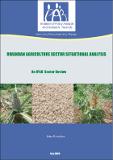| dc.contributor.author | Rwirahira, John | |
| dc.coverage.spatial | Rwanda | en |
| dc.date.accessioned | 2016-02-26T15:18:14Z | |
| dc.date.available | 2016-02-26T15:18:14Z | |
| dc.date.issued | 2009-08 | |
| dc.identifier.citation | Rwirahira, J. (2009) Rwandan agriculture sector situational analysis: an IPAR sector review. Kigali: Institute of Policy Analysis and Research-Rwanda. | en |
| dc.identifier.uri | https://opendocs.ids.ac.uk/opendocs/handle/20.500.12413/9593 | |
| dc.description.abstract | The main objective of this review is to provide reliable situation analysis of Rwandan
Agricultural sector and to recommend interventional strategies that would enable the
government and her development partners to come up with sustainable interventions
aimed at addressing the identified challenges. Eradicating Extreme Poverty and Hunger
is the number one Millennium Development Goals which is becoming more elusive for
various African countries because there is need to cut national poverty rate of each
African country by 30% instead of current 60%. Such reductions can only be possible if
agricultural sector contributions are accelerated in each African country especially sub
Saharan Africa (UNDP, 2007).
The methodology of conducting this situational analysis took cognizance of the general
consultations exercise popularly referred to as Stakeholders Engagement Exercise,
which observed with concern that poor performance in the agricultural sector poses
major constrain in Rwandan development. Policy documents of MINAGRI and other
associated agencies were reviewed including their strategies and Business Plans. The
aim of this first stage was to identify how all these, would fit into the general
development vision of the entire country as enshrined in the vision 2020. The second
stage was to interact with all key stakeholders in the agriculture sector, mainly those
directly involved in the day today implementation activities. The main purpose of these
interactions is to undertake overall assessment in the performance trend of their
respective activities.
In Rwanda, agriculture has been performing well compared to other sectors of the
economy. It should be understood that agricultural sector constitutes 90% employment
opportunities in the economy and 70% export revenue in the country. On the side of
provision of food, 91% of domestic food is generated by the agricultural sector. The
review discovered that Agriculture in Rwanda is mainly subsistence with over 90% of
output being food crops. Interestingly, 66% of the total food crops are meant for
domestic consumption while only 34% find their way to the market. On the side of
livestock, the growth has been reasonably steady at 7% per year especially on the side
of goats.
In order to enhance sector productivity and to pursue the EDPRS benchmarks, the
review made recommendations including Capacity Building to farmers on business skills
and marketing strategies so that their participation may shift from mere subsistence to
commercial farming. Observed also was low use of modern farming methods and
inputs. | en |
| dc.description.sponsorship | African Capacity Building Foundation (ACBF) | en |
| dc.language.iso | en | en |
| dc.publisher | Institute of Policy Analysis and Research- Rwanda | en |
| dc.rights.uri | http://creativecommons.org/licenses/by-nc-nd/4.0/ | en |
| dc.subject | Agriculture | en |
| dc.title | Rwandan agriculture sector situational analysis: an IPAR sector review | en |
| dc.type | Other | en |
| dc.rights.holder | Institute of Policy Analysis and Research - Rwanda | en |


